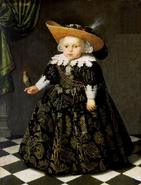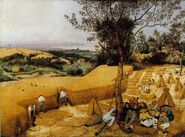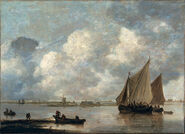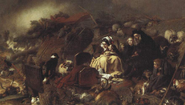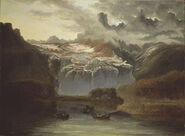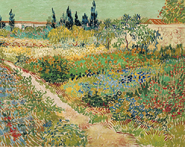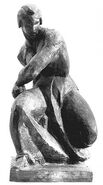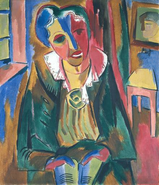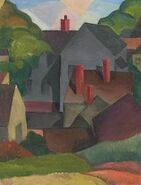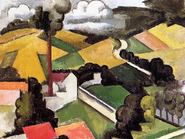Art in Brunant spans over a thousand years. Definitive Brunanter art began in the late 17th century and has evolved since, with domestic movements, but also following European trends.
Medieval art[]

Lady Serafina (1427)
Western medieval art was prevalent, especially from the 14th century, following the Conquest of Brunant.
One of the best-known artists from this period was the Master of Pabella (fl. 1416-1430); though his real name is unknown, he was known for his portraits, of notable independence figures and Founding fathers such as Hieronymus van der Ecke and Serafina de Larria. He is also well known for a fresco of the Adoration of the Kings, located at the Oude Kerk in Donderstad.
Renaissance art[]

The Burgundian Bride (1506)
Renaissance art was widespread in Brunant from the late 15th century to the 1610s. Most Brunanter art of this period had heavy Italian influences and it was known as the "Latin Style".
The "founder" of the Brunanter Renaissance was Wilhelmus Veldsteen (c.1455-1504), though the most famous painter of this era was Rickard Helsenberg (c.1480-1544). Born in Grijzestad, he traveled through central Europe and painted many people there. His best-known work is The Burgundian Bride, which is considered one of the finest Brunanter paintings of all time. Other painters of this era include Walter Bartel (c.1460-1512), Augustus van Barneveld (1486-1533), Alexander van Haeve (1487-1557) and Martin Viergens (1499-1561). Johannes Domenicus Cania was a notable sculptor of the period, responsible for many of the sculptures at Grijzestad Palace.
Selected paintings[]
Spanish Golden Age[]
The Spanish Golden Age was a period of flourishing in the arts and literature in Spain, coinciding with the rise of the Spanish Habsburg dynasty and the Spanish Empire. It lasted from the mid-16th century until the mid-17th century. Brunant, an independent kingdom at the time, was culturally, economically and politically very influenced by Spain. Brunanter arts in this period were also influenced by Spanish artists.
Some (art) historians deem the Spanish Golden Age in Brunant an offshoot of the 16th-century Renaissance era, which were both infused with the Italian Renaissance style. Notable artists in this period include Johannes Keep (1520-1602), Claus Vanderote (ca. 1555-1611) and Philip Mattheus (1578-1646). Keep was the court painter of Anders I and Willem I, while Vanderote and Mattheus's works were primarily commissioned by Adrian I.
17th century art[]
Art in the 17th century was still influenced by Spanish and Italian art though Dutch influences were evident.
The start of this "preclassical era" is said to begin with Carels Van Laesburg (1633-1702). His work was mostly on everyday life and tended to incorporate reds and browns. Antonius Hasselman (1640-1711) was a well-known contemporary and rival of V. Laesburg; both competed for the king's patronage but ultimately Van Draak chose Hasselman to paint his family portraits. Hans Fabre was also a well-known portraitist due to his detail and realism. Jan Van Hartsboch (c. 1655-1732) was a later painter of the preclassicals and focused of landscapes. A deep analysis of Van Hartsboch's work, letters and other references led to the conclusion that he was in fact a woman using a pen name, as it was easier for men's work to be sold and accepted. However his/her real name is unknown.
Paintings[]
Golden Age[]

Death on the land (1698)
The Brunanter Golden Age, also known as the Classical Era, (1690-c. 1730) is often considered by art connoisseurs to be the defining moment when Brunanter art took shape. The most prominent artist during this era was Johannes Neyt the Younger (1661-1724). He was a famed landscape painter who, although lived in poverty in his lifetime, is now well known. Much of his work has been lost over the years, and his work can command upwards of €80,000. Other painters who followed in his style were Jan van Helsinger (1672-1743), Andreus Ricard (1688-1851) and Blomefont van Stein (1679-1730), who's early work was heavily based on Neyt's style.
Art during this time consisted of abstract-like painting (somewhat similar to impressionism), where objects, landscapes and backgrounds were not clearly painted and often were just blended together. Art critics of the age called them the "Indefinites", due to not clearly defining landscapes and background. Notable works from this era include Death on the Land (Neyt, 1698), The Resilient Patriot (1707) and Blomefont van Stein's Roodstad Farmhouse (1727).
Paintings[]
Neoclassical art[]

The White Horse
The Neoclassical era (c. 1815-1850) was a movement reminiscent of the Golden age. It was obviously influenced by old masters like Blomefont van Stein and Neyt the Younger, but also from outside artists like J.M.W. Turner.
The earliest Neoclassical painter (often considered the founder of the movement) was Michael Emmett Springfield (1777-1845); he utilized the principles of the old masters but to greater extremes. In his White Horse (1839), for example, one can see some influences, but the background is much more abstract and the foreground image (the horse) is very well defined, giving a sharper contrast. Antonius Niesterfeld (1783-1854) became one of the most famous painters of this era; his Sinking Ship at the Foot of a Wave, painted in 1829, was only sold by him for Th. 650, but in a 2003 Sotheby's auction it realized €185,000. Other notable painters include Matthew Browning, Anthony Welland and Matthias van der Velt. Some later neoclassical art (such as Old Castle in the Countryside) tended to have some infleunce from the contemporary academics movements. Other work, like that of Eugenio Cavall was still utilizing lots of abstract design.
Paintings[]
Academics[]
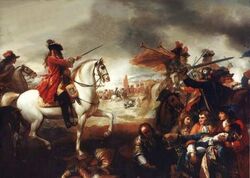
"Carrington Leading the Charge" (1822)
The Academics (1820-1860) was an art movement seen as a response to the neoclassicals. The paintings from this era were dramatic, detailed and "real". They often employed dark colors, shadows and small areas of light to give an impression of sheerness and magnitude.
Hans Rotmensen is considered the main exponent from this age. Two of his best-known works, The Destruction of War (1826) and Carrington Leading the Charge (1820-22) are large works with lots of figures, details and a sense of magnitude unseen with the classicals/neoclassicals. Other notable painters form this era include portraitist Pierre-Jules Chapron (1782-1861) and Michael Edward Winters (1798-1824), who tragically died young while his career was blossoming.
Paintings[]
Impressionism[]
Impressionism caught on in Brunant in the 1860s just as the academics began to wane. Impressionist art was initially heavily influenced by other European, and especially French painters. Later artwork such as Mrs. Wilmer's garden (1892) featured a more Brunanter style, with bright colors and designs.
Early artists include Carles Mannon (1833-1907), Johan Van Rijnsen (1829-180) and Edward Eldridge (1837-1912). A prominent painter from the later era was Eugenia Villes (1856-1928), who painted rich countryside landscapes from 1891-1905. Another one was Pierre Limburgh (1871-1904), famous for his landscapes.
Paintings[]
Fauvism/Postimpressionism[]

Down the River (1896)
The post-impressionist era (1895-c. 1910) was influenced partly by Matisse and the Fauvists in France, and also by an extension of Edward Eldridge's later art. Brunanter postimpressionists were moved by color and as the years passed their work became more vivid and bright.
Marie Durand (1873-1966) was an important post-impressionist active until the early 1910s. Stefan Malphy (1880-1955) was also a major painter of this era. Other notable painters were Herman De Witte and Ernest E. Talbot (Down the River).
Paintings[]
Expressionist movement[]
The expressionist era began around 1905-10 and was influenced by the corresponding movement in other European countries. Early expressionist art was seen as an extension (or evolution) of post-impressionism. Later works like Mathisen's Young Girl at a Table and Janzoon's The artist and his wife (both 1920) were more abstract and featured patterns and less graspable scenes.
Stefan Malphy was notable for his expressionist works, as was his longtime partner Cara Solby (1892-1974). Native Charles Towner Erin Lake (1887-1956) became known for her landscapes and mountain scenes.
Paintings[]
Cubism[]

The Country Road, Caroman (1926)
Cubism took hold in Brunant during the post-World War I period. Influenced by Picasso, Georges Braque and Juan Gris it developed over 20 years in Brunant.
The artist most associated with Brunanter cubism is is Caroman (1898-1944). Born Adrián Caroman, he became known for his master portraits. Though he was not the first cubist in Brunant, he was certainly the most well known of them all, commanding hefty sums for his work in the late 20s and 1930s. Other notable artists were William Favard (1886-1970), known for his landscapes and Abraham Hillard (1891-1965), who was one of the "revolutionaries" in this movement.
Cubism in Brunant continued until the mid-1930s and was considered "dead" by the onset of the Second World War.
Paintings[]
Avante-garde art[]
Brunanter avant-garde art took hold in the early 1930s and continued until the 1950s. Avant-garde artists painted in different styles and mostly painted non-figurative (abstract) art. Some of the most notable artists were Felix Prado and Stefanie Morton.
Avant-garde art was banned during the German Occupation and many works were confiscated as loot or destroyed.
Photographism[]

The Waiting Widow. Harold Ripley, 1947
Following World War II, many painters in Brunant began to paint what they saw, a nation in ruin, the destruction and the hope to rebuild it. This movement was known as photographism, neo-realism or neo-academy. Similar to the Academics of the mid-19th century, the photographists used detail to effect, and also aimed at capturing their sheerness.
Harold Ripley (1921-197) was a notable artist in this style, who captured every detail to bring an intensity to the artwork. His works (in the pre-1952 period) focused on wartorn scenes, grieving women and the pains of the nation. Other artists working in this genre were Andrew Miller and Adam van der Berg.
Pop art[]
Pop art in Brunant arose in the mid 1950s as a response to the perceived "blandness" of neo-realist art and a desire to move on from the war.
There was no defining or dominant artist during this era. Gabriel Blanchard was a well-known artist of the age, who experimented with various art styles. Other artists include Louise Hening, Piet Wasser and Edward Etse, who created minimalist art in the pop-art style of serigraphy. Pop art entered a second wave in the early 1980s, as so-called neo-pop, and found a resurgence in the late 1990s.
Paintings[]
Minimalism[]

The Gorge. MC Weissmann, 1961
Minimalist art took hold in Brunant in the late 1950s following European trends. In Brunant it became known for having dominant colors or tones and using simple shapes.
The earliest minimalist in Brunant was Jan Bertha (born 1924), who by 1957 was painting simple abstract works. MC Weissmann (1908-1996, wife of Michael Vandelet) was involved in the early stages of minimalism but later expanded the field to sculpture. While Bertha is considered the founder of Brunanter minimalism, Nathan Harding (born 1937) can be said to have popularized the genre in the early 1960s. Minimalism went out of popularity in the late 1970s and 1980s, but in the 2000s rebounded in popularity.
Paintings[]
Linear movement[]

Twang!. Susan Bolton (1963)
The Linear movement was contemporary to, and often considered a subset of 1960s Minimalism. This type of art was mainly centered on the use of bands, stripes and colorful lines. Some even used distorted lines for greater effect.
The father of Linear Art was Michael Vandelet (1903-1974), who moved away from the flowing abstractism of the 1950s through the use of lines. Other notable artists of the era were Susan Bolton and Ernest Lantham.
The Linear movement can be said to have died out in 1977-1980. After Vandelet's death there would be little interest. Nevertheless, there have been some neo-linears who have begun appearing since the late 1990s.
Paintings[]
Roundism[]
Roundism is a distinctly Brunanter art style developed in the 1980s. It is seen as a modern version of cubism, but adopting more fluid and round shapes, and combining line drawing over painted figures.
Brunanter Roundism has been led by Felix Tulse and David Boustani. These are among the original artists who developed the movement in the 1980s. In the late 1990s and 2000s younger artists began to lead the evolution of roundism, among them Isabela Mondes and Henry Pine.
Paintings[]
Stuckism[]
The art movement of stuckism was founded in 1999 in Britain. Today it is spread around the globe, with more than 230 stuckist groups. It is immensely popular in Brunant, unlike other countries.
The Brunanter Stuckists group is spearheaded by Hyacinth Bergqvist, an eccentric figure, dubbed "a modern Dali". Other significant stuckists are Josef Janz, as well as the talented Francha Abanto. Most of the Brunanter Stuckists are inspired by marginalized groups (e.g. prostitutes and LGTB people); hence they are refered to as the exclusionists.




